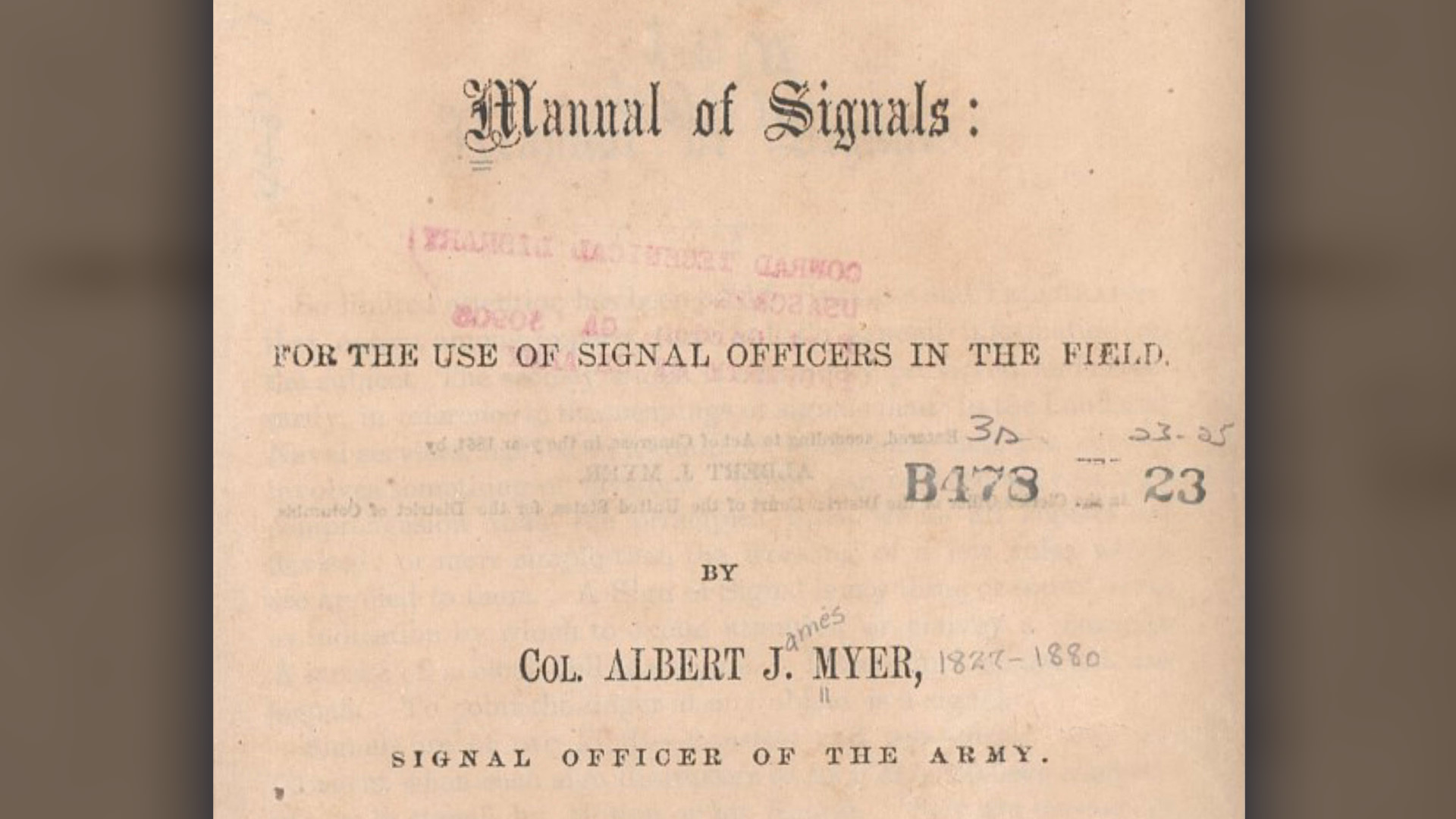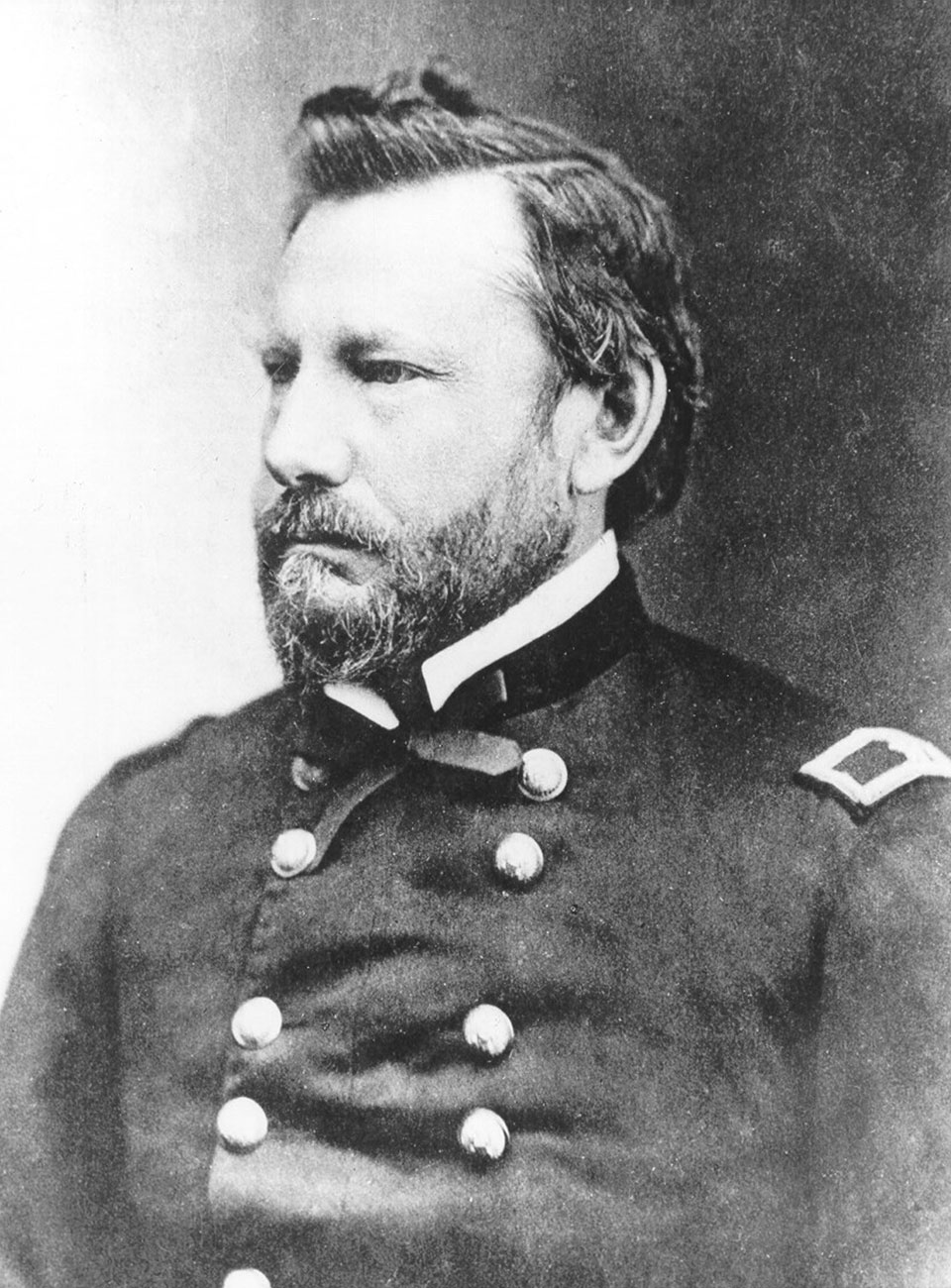Founding Father Myer’s First Signal Doctrine: A Manual of Signals
By Steven J. Rauch, Signal Corps Branch Historian
Article published on: September 1, 2024 in the Army Communicator Fall/Winter 2024 Edition
Read Time: < 8 mins

Cover page of Albert J. Myer’s Manual of Signals. (Signal Historical Collection)
In October 1864, a 148-page paperback booklet titled, A Manual of Signals: For the Use of Signal Officers in the Field was published. Written by Albert J.Myer, it was his desire to codify signal doctrine because he believed the Army needed a “signal textbookof some kind.” Since he had been dismissed as chiefsignal officer by Secretary of War Edwin Stanton inNovember 1863, Myer paid his own money to havethe manuscript privately published.
In the manual, Myer discussed in detail the principles of signaling as well as a short history of signal communications. He also discussed numerous subjects in extreme detail, such as how to devise codes, proper use of telescopes and binoculars, importance of proper maintenance of signal equipment, and how to conduct signaling in a field environment, especially considerations for selecting a signal station.
This manual, subsequently revised and expanded, remained the basic signal doctrine for several decades. Army doctrine today consists of a myriad of publications. From general Army Doctrine Publications (ADPs) to Field Manuals, to Training Circulars, and others, each is tailored to explain concepts or detailed information needed at each echelon. The Manual of Signals, however, contained everything from the philosophy of signal communication to how to devise codes and what was the best method to clean the lens of a telescope (hint: old newspaper was best to clean glass) in one book.
Myer began the manual by establishing a general concept of signals. He defined a signal as any sound, thing, act, or indication by which to excite a person’s attention to convey information. The stroke of a clock-bell is a signal. Letters and characters are signals. Pointing a finger at an object is a signal. Myer also defined the properties of a signal as being either transient or permanent. A signal was transient when the sign disappeared as soon as it was completed, such as a motion or sound. Signals were permanent when the signs remained extant for a period of time in a fixed position, such as a flag hoisted as a warning or other indication. Any characters or symbols written on paper or other suitable material were also a permanent signal.
Myer established the signaling principle that an arbitrary number of signs, sounds, things, colors, or indications, each distinguishable from the other, can be joined into combinations to produce a code using as few as two symbols. This binary foundation was the simplest form, but a code could be made more complex and versatile when more symbols were added, such as numbers 3 through 10. Doing so would enable almost infinite combinations to communicate more information to any extent required. For Myer, signaling, and therefore communicating, could be accomplished using any of the human senses.
In addition to visual, he argued that significations by sounds of any kind, such as the notes emanating from musical instruments, tapping a finger on differently sounding objects, or simply whistling were ways to convey information. A person could send messages by combining any two sounds which had designations assigned to them making a binary code. He gave tapping on a book as one example and on a candlestick for two. This method, known as a “tap code,” would be used much later during the Vietnam War by American prisoners of war as a way to communicate with each other during their confinement.
During his medical studies, Myer had focused on how to communicate with deaf persons who could not hear sounds. He devised a method that used significations by generating sensations on a person’s skin through touch by a rough or smooth object, a sharp or dull point, long pressure and short pressure, or taps with a finger upon the hand. The different sensations could be designated by numbers into a code. A sharp touch could be one and a dull touch as two. Carrying the concept further, he concluded with the final two senses: taste and smell. Significations by taste was accomplished using food ingredients with distinct flavors such as salt, sugar, or mustard. This included drinks such as brandy, cider, and water; each of which could be given a designation as one, two, and three, thus enabling development of a code with three characters. Smell, too, could be leveraged for communications such as perfume odor, like rose, violet and hyacinth, which could be designated as elements one, two or three. Myer concluded these examples illustrated the endless application of the principles of signals through every sense, in a language fitted for that sense, as intelligibly as speaking to one another with our voices.

Brig. Gen. Albert J. Myer. (Signal Historical Collection)
As to more practical matters, Myer’s manual reflected a serious view about the signal function and duties of signal Soldiers. He made several pronouncements such as, “The senior officer on a station, or with any party, is primarily responsible for the condition of all the apparatus; and it is his duty to see, each day, that the whole equipment is ready for instant service. Officers should be held responsible with their commissions for the proper discharge of this duty.”
Another example was implementing security measures to deny the enemy advanced technology. He strongly admonished signalmen that, “Telescopes ought never be allowed to fall into the hands of the enemy. Officers, on dangerous stations, ought to conceal their glasses when not in use. If an officer is in danger of capture, and there are no means of concealment, the telescope glasses must be shattered or rendered worthless rather than surrendered.”
Myer also explained that signaling involved numerous Soldiers to accomplish the mission, and therefore, conflicts and issues between signal organizations should be minimized. He said, "[Equipment] habitually used for signals in the field should be cared for with scrupulous exactness. Defects in [equipment] not only annoy the signalist himself, sending the message, but they annoy the person to whom messages are imperfectly sent. A decent, courteous regard for the rights of others ought, of itself, to prevent any person from inflicting on another the consequences of his own carelessness.” In other words, consider others while going about your duties.
He also explained how each signaling team, station, or section should develop their own unique identifier or call sign by which they could be known. This signal, known as the "officers’ signature or call," served to distinguish messages sent by him. It also designated the station at which the officer commanded so to distinguish that station from others. Whenever the particular “call” was signaled, it was intended to draw the attention of the desired officer or station. The station should then respond using the same call so they could confirm they were ready to receive information.
On the battlefield, Myer was specific about where the chief signal officer of an army or corps needed to be. He said that the chief signal officer (today’s G-6) should report to the commanding general and learn the plans for the upcoming engagement. The chief signal officer needed to know the probable position where the commanding general would be located so the headquarters signal station could be established. The chief signal officers of each corps should be notified of that position so they knew where to connect their stations to that of the commanding general.
An important part of the manual was Myer’s discussion about “complicating signals,” or in modern terms, encryption of codes so that the enemy could not read the message transmission. When the Civil War began, Myer’s wig-wag system was compromised immediately because his assistant, 2nd Lt. Edward Porter Alexander, joined the Confederate army and began using that system against his former army. Because the wig-wag system was identical, the Confederate army could steal U.S. Army signals, much as college and professional sports teams steal visual signs today, to gain an advantage over an opponent. Because of this, Myer developed an encryption method using a cypher disk to protect message traffic sent via the wig-wag. Protection of signal communications, no matter what form, was an utmost priority for a signal officer who was instructed to destroy any keys if they were in danger of being captured.
The last section of the Manual of Signals was devoted to the duties of signal officers. He believed that a signal officer’s value to a commander was the same as “a confidential secretary,” through which important dispatches, encrypted messages, and other information was recorded and then transmitted through the appropriate system. In sum, the duty of a signal officer was to “connect the corps of an army in the presence of an enemy by the most rapid communications; to secure the quickest transmission of intelligence in the army; and such information as may bear upon its movements.” When unable to operate the assigned communications systems, officers were not to be idle, but to serve as intelligence gatherers through observation, scouting and reconnaissance. In Myer’s words, “Detachments of the Signal Corps, properly handled and equipped, should aim to make themselves for that army its eyes, ears, and tongue.”
Today, most people would view a book written in 1864 as outdated or no longer relevant for military operations. However, that would be a mistake. Devising codes to establish meaning; securing those codes from enemy knowledge; understanding, maintaining, and employing information transmission systems; knowing what a commander intends to do in a pending operation; and ensuring information is communicated in a clear and complete manner was, is, and will always be the essence of getting the message through.